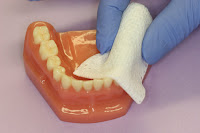1.) When checking the shade for a composite or crown, ask you patient if they have any plans to whiten their teeth in the near future so you can select the shade accordingly.
2.) If your patient has a beautiful smile - tell them! Ask if they would like to enhance it even more by whitening their teeth.
4.) Ask your patient if they have any cosmetic concerns or if they had the opportunity, would they change anything about their smile - most say color.
5.) If someone says, "I never thought about whitening" - take out the shade guide and ask them what shade they think matches the color of their teeth. Most of the time, people think their teeth are several shades lighter than they actually are. With a hand mirror, show them the shade they selected against their teeth. You can also show them a lighter shade they could potentially be after whitening.
After seeing the difference in shade and looking in the mirror, many patients will schedule for in-office whitening. If possible, offer to take the alginate impression for the whitening trays the same day. If offered in your office, outside financing is a great way to make in-office whitening procedures very affordable. In fact, with Care Credit, our patients can break our whitening fee down into twelve affordable monthly payments. These payments are actually less than the cost of some premium whitening strips sold over-the-counter, and of course, the results will last much longer.
For details on fabricating whitening trays, please see Diva Tips.
For details on fabricating whitening trays, please see Diva Tips.





